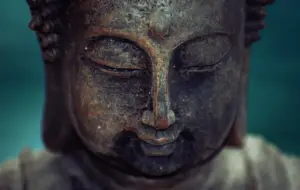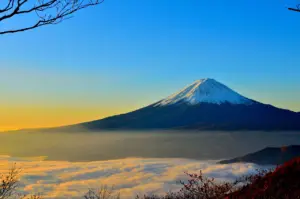Are you curious about the similarities and differences between Shinto and Buddhism? Both are prominent religions in Japan that have coexisted for centuries.
While Shinto is considered the indigenous religion of Japan, Buddhism was introduced to the country in the 6th century. Despite their origins, these two religions have influenced each other over time, resulting in some similarities and differences in their beliefs and practices.
In this article, you will delve into the core beliefs and practices of both Shinto and Buddhism, including their views on supernatural beings and the afterlife. You will also learn about the influence that each religion has had on the other, as well as the distinctions that make them unique.
Whether you are interested in exploring these religions for personal or academic reasons, this article will provide you with a thorough comparison of Shinto and Buddhism.
Key Takeaways
- Shinto and Buddhism are both prominent religions in Japan, with Shinto being considered the indigenous religion and Buddhism being introduced in the 6th century.
- Both religions share a reverence for natural spirits and ancestors, reflecting a deep respect for the interconnectedness of all things.
- The ultimate goal in Buddhism is to attain enlightenment through the Eightfold Path, while in Shinto, it is achieving Makoto, or sincerity and true heart, which is emphasized in the concept of Kami.
- While there are differences in deities, supernatural beings, and afterlife beliefs, both religions stress the importance of living in harmony with nature and cultivating positive qualities such as compassion, kindness, and gratitude.
Brief Overview of Shinto and Buddhism
So, let’s take a quick peek at what Shinto and Buddhism are all about, shall we?
Shinto is an indigenous religion of Japan that focuses on the veneration of spirits, known as kami. It is believed that the kami are present in all things, including nature, animals, and even human beings. Shinto has no formal scripture and relies on rituals and traditions that have been passed down through generations.
Shinto is deeply rooted in Japanese culture and has influenced many aspects of daily life, such as architecture, festivals, and art.
On the other hand, Buddhism originated in India and was introduced to Japan in the 6th century. Buddhism is based on the teachings of Siddhartha Gautama, also known as the Buddha, who sought enlightenment and taught the Four Noble Truths and the Eightfold Path.
Buddhism emphasizes the impermanence of all things and the importance of achieving enlightenment to escape the cycle of suffering and rebirth. Unlike Shinto, Buddhism has a formal scripture, the Tripitaka, and is practiced worldwide.
Buddhism has also had a significant impact on Japanese culture, particularly in the fields of philosophy and art.
Beliefs and Practices of Shinto
When discussing beliefs and practices of Shinto, it’s important to understand the worship of natural spirits and ancestors.
In Shinto, there is a deep reverence for the natural world and the spirits that inhabit it, with the belief that everything in nature has its own unique spirit.
Additionally, achieving harmony with the universe is a central goal in Shinto, with the belief that by living in harmony with nature and the divine, one can achieve a sense of balance and peace in their life.
Worship of Natural Spirits and Ancestors
You’ll find that in both Shinto and Buddhism, there is a shared reverence for natural spirits and ancestors, which reflects a deep respect for the interconnectedness of all things. In Shinto, the worship of natural spirits, called kami, is a central part of the religion. These spirits are believed to inhabit all things in nature, such as rocks, trees, bodies of water, and even human beings. The kami are seen as both benevolent and malevolent, and it is the duty of humans to maintain a positive relationship with them through offerings and rituals.
Similarly, in Buddhism, the worship of ancestors and natural spirits is also prevalent. However, the focus is not on the worship of specific spirits or deities, but rather on the recognition of the interconnectedness of all things through the concept of interdependence. Buddhists believe that all living beings are interconnected and that the actions of one being can affect the entire universe. Therefore, the practice of respecting and honoring one’s ancestors is seen as a way to maintain a positive relationship with the interconnected web of existence. Overall, the worship of natural spirits and ancestors in both Shinto and Buddhism reflects a deep respect for the interconnectedness of all things and the importance of maintaining positive relationships with those around us.
| Shinto | Buddhism | |
|---|---|---|
| Worship of natural spirits, called kami | Worship of ancestors and natural spirits | |
| Spirits inhabit all things in nature | Focus on the recognition of interdependence | |
| Maintaining positive relationship through offerings and rituals | Respecting and honoring ancestors as a way to maintain positive relationship with all of existence | …and to ensure their continued guidance and protection for future generations. |
Goal of Achieving Harmony with the Universe
If you truly want to achieve harmony with the universe, it’s important to understand the interconnectedness of all things and the impact of your actions on the world around you. This is a fundamental belief shared by both Shinto and Buddhism. Both religions believe that the ultimate goal of one’s spiritual journey is to attain harmony with the universe.
To achieve this goal, both Shinto and Buddhism emphasize the importance of self-reflection and inner peace. In Shinto, this is achieved through the practice of ‘misogi,’or purification rituals, which involve cleansing the body and mind in order to connect with the divine. In Buddhism, the path to inner peace is through the practice of meditation, which involves quieting the mind and focusing on the present moment.
Both religions also emphasize the importance of living in harmony with nature, recognizing that our actions have a direct impact on the environment around us.
In order to achieve harmony with the universe, both Shinto and Buddhism also stress the importance of cultivating positive qualities such as compassion, kindness, and gratitude. This is achieved through the practice of ‘shintai’in Shinto, which involves showing respect and gratitude towards the natural world and the spirits that inhabit it.
In Buddhism, this is achieved through the practice of the ‘Four Immeasurables’- love, compassion, joy, and equanimity – which help to cultivate a sense of interconnectedness and empathy towards all living beings.
Ultimately, the goal of achieving harmony with the universe is a journey that requires self-reflection, inner peace, and a deep understanding of our place in the world.
Beliefs and Practices of Buddhism
When discussing the beliefs and practices of Buddhism, it’s important to understand the emphasis on achieving enlightenment.
This is the ultimate goal for Buddhists, as it allows them to reach a state of peace and understanding.
Through meditation and ethical living, Buddhists believe they can end suffering and achieve this state of enlightenment.
Importance of Achieving Enlightenment
Imagine reaching a state of complete knowledge and understanding, where all suffering and ignorance are eliminated – this is the ultimate goal of both Shinto and Buddhism. In Buddhism, this state is called enlightenment or Nirvana, and it is considered the highest achievement one can attain.
The importance of achieving enlightenment is emphasized in the Four Noble Truths, which state that the cause of suffering is desire and ignorance, and that by eliminating these, one can achieve Nirvana. In Buddhism, the path to enlightenment involves following the Eightfold Path, which includes right understanding, intention, speech, action, livelihood, effort, mindfulness, and concentration.
In Shinto, the equivalent to enlightenment is called Makoto, which means sincerity or true heart. This state is achieved through the practice of purity, which involves being honest, genuine, and sincere in one’s actions and intentions. The importance of achieving Makoto is emphasized in the concept of Kami, which are divine spirits that are believed to exist in all things.
By achieving Makoto, one can become one with the Kami and attain a state of harmony with the natural world. While the paths to enlightenment in Buddhism and Shinto differ, both religions emphasize the importance of achieving a state of complete knowledge and understanding in order to eliminate suffering and ignorance.
End of Suffering through Meditation and Ethical Living
Now that you understand the importance of achieving enlightenment in both Shinto and Buddhism, let’s talk about how one can end suffering through meditation and ethical living. This is a crucial aspect of both religions, as it’s believed that suffering arises from attachment to material things and desires. By letting go of these attachments, one can attain inner peace and reach a state of enlightenment.
To achieve this, both Shinto and Buddhism recommend practicing meditation and following ethical principles. Here are some ways you can incorporate these practices into your daily life:
-
Start by setting aside some time each day for meditation. Find a quiet place where you can sit in a comfortable position and focus on your breath. This will help calm your mind and reduce stress.
-
Practice mindfulness throughout the day. This means being fully present in the moment and paying attention to your thoughts and actions. By doing so, you can become more aware of your desires and attachments and learn to let them go.
-
Follow ethical principles such as compassion, kindness, and honesty. Treat others with respect and don’t harm them in any way. This will help you cultivate a positive mindset and create good karma.
-
Finally, remember that achieving enlightenment is a lifelong journey. Be patient with yourself and don’t expect immediate results. Keep practicing, and you’ll eventually reach your goal.
Influence of Shinto on Buddhism
You might be surprised to learn that Shintoism has had a significant influence on Buddhism. When Buddhism was first introduced to Japan in the 6th century, it was met with resistance from the native Shinto religion. However, over time, the two religions began to merge and influence one another.
This syncretism resulted in the creation of a unique Japanese form of Buddhism known as ‘Shinbutsu-shugo,’ which combined elements of both religions. One way in which Shintoism influenced Buddhism was in its emphasis on ancestor worship and nature worship.
Shintoism believes in the existence of kami, or spirits, that inhabit natural objects and places, and ancestors are also revered as kami. This belief was incorporated into Japanese Buddhism, resulting in the creation of ancestral altars in Buddhist temples and the worship of nature spirits alongside Buddhist deities.
Overall, the influence of Shintoism on Buddhism in Japan has led to a unique and complex religious landscape that blends both traditions seamlessly.
Influence of Buddhism on Shinto
If you’ve ever visited a Shinto shrine in Japan, chances are that you’ve encountered some Buddhist elements, such as the use of incense and prayer beads, which were incorporated into Shinto practices as a result of Buddhism’s influence. However, the influence of Buddhism on Shinto goes beyond just superficial aspects.
Here are four ways in which Buddhism has impacted Shinto:
-
The concept of karma – Shinto traditionally didn’t have a clear concept of karma, but it was introduced by Buddhism and has since become a key component of Shinto belief.
-
The idea of rebirth – Buddhism’s emphasis on rebirth has also seeped into Shinto beliefs, with some Shinto practitioners now believing in the cycle of birth, death, and rebirth.
-
The use of meditation – While Shinto traditionally didn’t incorporate meditation into its practices, Buddhism’s emphasis on meditation has influenced some Shinto practitioners to adopt meditation techniques.
-
Philosophical concepts – Buddhism’s emphasis on philosophical concepts such as emptiness and impermanence has also influenced some Shinto practitioners, who now incorporate these ideas into their understanding of the world and their place in it.
Overall, Buddhism has had a significant impact on Shinto, not just in terms of visible practices, but also in terms of shaping some of the core beliefs and philosophies of the religion.
Differences in Deities and Supernatural Beings
Amidst the colorful tapestries and flickering candles, an array of deities and supernatural beings are worshipped in both Shintoism and Buddhism. However, there are notable differences in their belief systems regarding these entities.
In Shintoism, the deities or kami are considered to be present in all things, from mountains and rivers to animals and even rocks. These kami are revered and respected, but aren’t worshipped in the same way as gods in other religions.
On the other hand, Buddhism has a pantheon of gods and goddesses, known as devas, who are considered to be higher beings that exist in different realms of existence. Additionally, Buddhism also recognizes supernatural beings such as ghosts, demons, and hungry ghosts, which aren’t present in Shintoism.
The differences in the belief systems of these two religions regarding deities and supernatural beings highlight the distinctiveness of each religion’s approach to spirituality.
Differences in Afterlife Beliefs
As you continue to explore the differences between Shinto and Buddhism, it’s important to consider their beliefs about death and the afterlife.
In Shinto, death is viewed as a natural part of life, and the afterlife is not a major concern.
On the other hand, Buddhism places a strong emphasis on reincarnation and achieving Nirvana, a state of ultimate enlightenment and liberation from the cycle of rebirth.
Understanding these distinct views on the afterlife in both religions can give you a deeper understanding of their respective worldviews.
Shinto Views on Death and the Afterlife
You may be curious about how Shinto views death and the afterlife, and it’s interesting to note that their beliefs differ from those of Buddhism.
Here are some key points to help you understand Shinto’s perspective on death and the afterlife:
-
Shinto does not have any specific teachings or doctrines about an afterlife or reincarnation. Instead, the focus is on honoring and respecting the spirits of ancestors and nature.
-
Death is seen as a natural part of the cycle of life, and mourning is not as prominent as it is in other cultures. Instead, Shinto encourages people to celebrate the life of the deceased and continue to honor their memory through offerings and rituals.
-
Shinto believes that the soul becomes a kami, or a divine spirit, after death. This means that ancestors are still present and can offer guidance and protection to their living descendants.
-
Shinto also places a strong emphasis on purity and cleanliness, which is why rituals such as purification and cleansing are common before and after death.
-
Ultimately, Shinto’s views on death and the afterlife are rooted in a deep reverence for nature and the spiritual world.
While it may differ from other religions, its focus on honoring the spirits of ancestors and nature remains a central part of Shinto beliefs.
Understanding Shinto’s beliefs about death and the afterlife can offer a unique perspective on human spirituality and the relationship between humans and the natural world. While it may not offer the same concrete ideas about an afterlife as other religions, Shinto’s focus on honoring and respecting the spirits of ancestors and nature can provide comfort and guidance for those who practice it.
Buddhist Views on Reincarnation and Nirvana
If you’re interested in delving deeper into Buddhist beliefs, it’s worth exploring their views on reincarnation and ultimate spiritual liberation known as Nirvana.
Buddhists believe in the cycle of rebirth, also known as Samsara, where individuals are reborn into different realms based on their karma or actions in their previous lives. The ultimate goal for Buddhists is to break free from this cycle and attain Nirvana, a state of complete enlightenment and liberation from suffering.
Reincarnation in Buddhism is not seen as a permanent state, but rather a continuous cycle of birth and death. The nature of one’s rebirth is determined by their actions and thoughts in their previous lives, with good actions leading to positive rebirths and negative actions leading to negative rebirths.
However, Buddhists believe that the cycle of reincarnation can be broken through the practice of the Eightfold Path, which includes concepts such as mindfulness, right action, and right speech. By following these principles, individuals can attain Nirvana and break free from the cycle of rebirth.
Frequently Asked Questions
How did Shinto and Buddhism come into contact with each other?
When Buddhism was introduced to Japan in the 6th century, it came into contact with the already established Shinto religion. At first, the two religions coexisted peacefully, with some Shinto shrines even adopting Buddhist practices and deities.
However, as time passed, conflicts arose between the two religions. Buddhism, with its emphasis on detachment and the ultimate goal of enlightenment, clashed with the more earthly and ritualistic Shinto beliefs. This tension eventually led to the creation of a syncretic form of religion known as Shinbutsu-shÅ«gÃ…Â, which combined elements of both Shinto and Buddhism.
Today, many Japanese people practice a blend of both religions, with Shinto being the more popular choice for traditional ceremonies and Buddhism being more commonly associated with funerals and the afterlife.
How do Shinto and Buddhism differ in terms of their views on moral conduct?
When it comes to moral conduct, Shinto and Buddhism have some key differences.
Shinto places a strong emphasis on purity and cleanliness, and followers are expected to maintain these qualities in all aspects of their lives. This includes practices such as ritual purification and the avoidance of impure acts and objects.
Buddhism, on the other hand, focuses more on the concept of karma and the idea that one’s actions have consequences. This means that followers are encouraged to act in ways that will lead to positive outcomes in future lives, rather than simply avoiding impurity in the present.
Additionally, Buddhism places a greater emphasis on compassion and helping others, while Shinto is more focused on maintaining harmony with the natural world.
Overall, while there are some similarities in the moral teachings of Shinto and Buddhism, the two religions have different approaches to the concept of moral conduct.
Are there any similarities between Shinto and Buddhism in terms of their rituals?
When it comes to rituals, both Shinto and Buddhism share similarities and differences. Shinto rituals often involve purification and offerings to kami, or the spirit gods. These rituals can take place at shrines, which are considered the homes of the kami.
Similarly, Buddhist rituals can involve offerings and prayers to various deities and Buddha statues. However, Buddhist rituals also involve meditation and chanting, which aren’t typically found in Shinto rituals.
Additionally, Buddhism emphasizes the importance of the Eightfold Path, which involves moral conduct, while Shinto doesn’t have a specific moral code. Despite these differences, both religions place a strong emphasis on the importance of ritual and honoring the divine.
How do Shinto and Buddhism differ in their concepts of salvation or liberation?
When it comes to the concepts of salvation or liberation, Shinto and Buddhism have different approaches. In Shinto, there’s no specific idea of salvation or liberation. Instead, the focus is on maintaining a harmonious relationship between humans and the natural world.
On the other hand, Buddhism places great emphasis on the attainment of enlightenment and liberation from the cycle of rebirth. The path to liberation in Buddhism involves following the Eightfold Path and the Four Noble Truths. Additionally, Buddhism also incorporates the idea of karma and rebirth, which aren’t present in Shinto.
Overall, while both religions have their own unique beliefs and practices, their approaches to salvation and liberation differ significantly.
How has the relationship between Shinto and Buddhism evolved over time in Japan?
Over time, the relationship between Shinto and Buddhism in Japan has been complex and multifaceted. Initially, the two religions coexisted in relative harmony, with Buddhist temples often being built on or near Shinto shrines.
However, as Buddhism gained more influence and power in Japan, it began to absorb certain aspects of Shinto, such as the idea of kami (spirits or deities) and the practice of ancestor worship. This led to the development of a uniquely Japanese form of Buddhism called ‘Shinbutsu-shÅ«gÃ…Â’or ‘fusion of Shinto and Buddhism.’
During the Meiji Restoration in the late 19th century, the government sought to separate the two religions in order to promote nationalism and modernization. This resulted in the suppression of many Buddhist practices and the revitalization of Shinto as the state religion.
Today, both Shinto and Buddhism continue to be practiced in Japan, often side-by-side, with many Japanese people incorporating elements of both into their spiritual lives.
Conclusion
Now that you’ve explored the similarities and differences between Shinto and Buddhism, it’s clear that these two religions have had a significant impact on each other.
While Shinto emphasizes the importance of maintaining a close relationship with nature and ancestors, Buddhism focuses on the attainment of enlightenment and the path to end suffering.
Despite these differences, both religions share a belief in the existence of supernatural beings and the importance of rituals and ceremonies.
The influence of Shinto on Buddhism can be seen in the incorporation of Shinto deities and practices into Buddhist temples and festivals.
Similarly, Buddhism has influenced Shinto with its emphasis on meditation and the concept of karma.
Overall, the similarities and differences between these two religions highlight the diverse ways in which people seek to understand the world around them and connect with the divine.

































































































